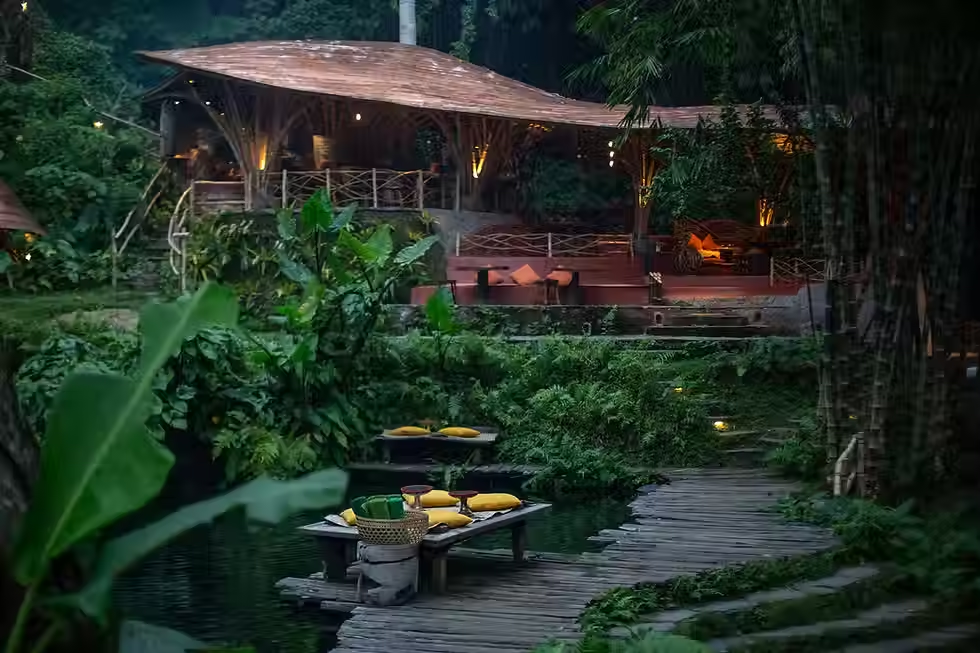7 Luxury Hotel Restaurants Celebrating Eco Art
- Ezgi Atay
- 3 Haz 2025
- 3 dakikada okunur
In a world where discerning travellers increasingly value purpose alongside pleasure, luxury hospitality is evolving. Today’s most compelling hotel restaurants are no longer just about gourmet menus or picturesque views they are immersive experiences where sustainability meets sensory storytelling. A rising number of them are embracing eco art: sculptural design, installations, and architectural forms made from recycled, natural, or locally sourced materials. The result? Spaces that not only nourish the body but inspire the soul.
Here are seven exceptional hotel restaurants around the globe where eco-conscious creativity takes centre stage:
1. Soneva Fushi, Maldives – Out of the Blue
Perched above the turquoise waters of the Indian Ocean, Out of the Blue is more than a dining destination it's a tribute to the art of regeneration. Within this multi-level bamboo structure lies a fully functioning glass studio where discarded bottles are transformed into glittering art installations and tableware. Driftwood sculptures and ocean-salvaged décor add a poetic touch, reminding guests of the delicate beauty and fragility of our seas.
Eco Art Highlights:
Sculptural lighting from recycled glass
Marine debris turned into décor
Bamboo architecture blending with sea and sky

Soneva Fushi. Photo Published by the Hotel.
2. Bambu Indah, Bali – River Warung
Set by a sacred river and wrapped in lush jungle, River Warung at Bambu Indah is a masterclass in barefoot luxury. The restaurant is crafted entirely from reclaimed Javanese teak and hand-shaped bamboo, where each arch and corner speaks of reverence for the Earth. Nature itself becomes the artist lava rocks, clay, and vines weave through the structure, creating a space that feels alive.
Eco Art Highlights:
Furniture from repurposed timber
Installations made with vines and volcanic stone
Living architecture with zero plastic

3. Azulik Uh May, Tulum – Kin Toh
Dining at Kin Toh is like stepping inside a sculpture. Suspended among treetops, this extraordinary venue is part restaurant, part eco-art gallery. Crafted entirely from locally sourced wood, vines, and natural thatch, the experience dissolves the line between the built and natural worlds. Organic forms ripple through the space, mirroring jungle canopies and ocean waves.
Eco Art Highlights:
Floating walkways and pod-like dining nooks
Restaurant built with found wood and vines
Onsite gallery showcasing sustainability-themed works

4. Alila Yangshuo, China – Sugar House Restaurant
Housed in a transformed 1960s sugar mill, Sugar House fuses raw industrial heritage with sleek sustainable design. Exposed stone walls, rusted steel, and reclaimed wood become unexpected elements of beauty. Vintage machinery is repurposed into large-scale sculptural art, anchoring the space in history while pointing to a more conscious future.
Eco Art Highlights:
Art from industrial relics
Locally quarried stone walls
Restaurant set within a preserved architectural ruin

Alila Yangshuo. Photo Published by the Restaurant.
5. Six Senses Fort Barwara, India – The Cortile
Set within a 14th-century fort, The Cortile offers a unique blend of regal elegance and eco-conscious restoration. Walls are adorned with murals created using natural pigments and traditional techniques. Each element, from lighting to tableware, has been locally sourced or repurposed, celebrating India's artisan legacy through a sustainable lens.
Eco Art Highlights:
Hand-painted natural murals
Repurposed fort materials as décor
Earth-toned design rooted in local craft

Six Senses, Fort Bavara. Photo Published by the Hotel.
6. Babylonstoren, South Africa – Babel Restaurant
Babel’s design is as edible as its menu. Housed in a converted cowshed on a historic wine farm, it pairs bold farm-to-table cuisine with whimsical, ever-evolving eco-art. Installations made from old tools, orchard clippings, and garden waste turn seasonal leftovers into design moments. Here, art grows, blossoms, and composts.
Eco Art Highlights:
Sculptures made from garden trimmings
Upcycled tools and wine crates
Seasonal décor that changes with the harvest

Babel Restaurant, Green House. Photo Published by the Hotel.
7. Hoshinoya Tokyo, Japan – Kaiseki Dining Room
In Japan, the art of simplicity often says the most. Hoshinoya Tokyo’s dining room channels wabi-sabi philosophy through natural textures and minimalist design. Locally made ceramics, hand-thrown using centuries-old techniques, double as both tableware and artistic expression. It’s eco art in its most refined form quiet, intentional, and deeply rooted in place.
Eco Art Highlights:
Handcrafted ceramics from local kilns
Use of wood, stone, and washi paper
Organic forms echoing Japanese nature

Hoshinoya, Tokyo. Photo Published by the Hotel.
As sustainability becomes the new standard in luxury, hotel restaurants are uniquely positioned to tell richer, more responsible stories. These examples show how eco art isn't just decoration it's a philosophy. A way of seeing the world, shaping spaces, and reminding guests that beauty and environmental integrity can coexist in extraordinary harmony.


